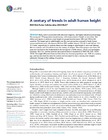A century of trends in adult human height
Citation
NCD Risk Factor Collaboration (2016) 'A century of trends in adult human height.' eLife 5(13410), pp. 1-29. DOI: 10.7554/eLife.13410.

View/
Date
2016Author
Murtagh, Elaine
NCD Risk Factor Collaboration (NCD-RisC)
Peer Reviewed
YesMetadata
Show full item record
NCD Risk Factor Collaboration (2016) 'A century of trends in adult human height.' eLife 5(13410), pp. 1-29. DOI: 10.7554/eLife.13410.
Abstract
Being taller is associated with enhanced longevity, and higher education and earnings. We reanalysed 1472 population-based studies, with measurement of height on more than 18.6 million participants to estimate mean height for people born between 1896 and 1996 in 200 countries. The largest gain in adult height over the past century has occurred in South Korean women and Iranian men, who became 20.2 cm (95% credible interval 17.5–22.7) and 16.5 cm (13.3– 19.7) taller, respectively. In contrast, there was little change in adult height in some sub-Saharan African countries and in South Asia over the century of analysis. The tallest people over these 100 years are men born in the Netherlands in the last quarter of 20th century, whose average heights surpassed 182.5 cm, and the shortest were women born in Guatemala in 1896 (140.3 cm; 135.8– 144.8). The height differential between the tallest and shortest populations was 19-20 cm a century ago, and has remained the same for women and increased for men a century later despite substantial changes in the ranking of countries.
Keywords
CenturyTrend
Adult
Human
Height

